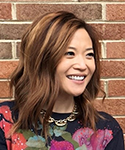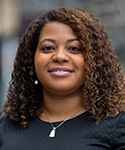Two summers ago, I was on a guided tour with a group of Duke Youth Academy kids at the International Civil Rights Center & Museum in Greensboro, North Carolina. The museum itself is a historic landmark, housed in the Woolworth building where the 1960 lunch counter protest launched the sit-in movement that swept across the American South.
As we walked through each exhibit of this museum, I imagined what it would have been like for active participants in this momentous time in history. What was it like for pastors to lead their congregations through desegregation and integration? What was it like for these students at the lunch counter, day in and day out, waiting for justice? How many of us would have marched with Martin Luther King Jr.?
We moved into the exhibit titled “Direct Action” and observed the collective work of activists in Southern states that ultimately led to the passing of the Civil Rights Act of 1964 and the Voting Rights Act of 1965.
We came upon a large wall with 800 mug shots of young college student volunteers for the Freedom Summer project of 1964, an effort dedicated to increasing Black voter registration in Mississippi despite intense voter intimidation and discrimination from white supremacist groups.
The young volunteers underwent an intense screening and training process. They were told to brace themselves for the impending hostility from white supremacist groups, and many were indeed arrested.
The 800 mug shots filled the entire wall with brave but tired faces. As the tour guide ushered us to the next exhibit, one of the photos caught my eye and I stopped for a closer look. Among the crowd of white and Black faces was an Asian man.
He did not seem to belong there, yet his mug shot was firmly and permanently affixed to the wall of the International Civil Rights Museum, permanently affixed to American civil rights history. Who was this man, and how did he end up as a civil rights protester? How did he end up in a civil rights museum? I had to tear my eyes away as our party was quickly ushered to the next room, but I was determined to find out more.
Asian Americans, particularly Northeast Asian Americans, have a history of anti-Blackness in the United States. The racialization of nonwhite people groups by white America has resulted in a hierarchy of minoritized groups, striated by relative proximity to the privileges of being white.
Asian Americans, labeled the docile and hardworking “model minority,” have been used to perpetuate anti-Black and brown sentiments, and the hierarchy as a whole has created competition for limited resources, pitting minoritized groups against each other and preventing the progress of all. This false striation is the key to fostering interracial prejudices and violence against each other, ultimately benefiting white supremacy.
I remember feeling conflicted during the 1992 Los Angeles riots, when Korean families experienced business losses and violence from the Black communities where their businesses were located. At the same time, Black folks were tired of being policed and treated like criminals by Koreans.
I heard fear and anger among my Korean family and friends as they tried to survive in America, yet I personally witnessed many of them taking part in racial profiling, policing and affirming the stereotypes of the racial hierarchies that white America defined for us all.
These sorts of tensions between Asian communities and Black communities are still very present today. Tou Thao, the police officer of Hmong descent arrested for standing idly by while his white colleague killed George Floyd, sparked debate among various Asian communities, some standing in solidarity with the Black Lives Matter movement and others blaming protestors for racial violence.
Many Asians have experienced blame and violence for the COVID-19 virus, even if they have never been to China. As Asians have named the xenophobic and discriminatory violence they have faced, they have been surprised when some Black and brown communities have not immediately stood in solidarity with them.
I finally returned to the museum this past summer, with special permission to visit, along with my two sons. Masked and sanitized, we found the picture of the Asian man on the wall. I looked closely at his profile, typed in small letters.
Name: Paik, Dan, Korean Male, alias: Daniel Ernest Paik, 5'7", 157 lbs., brown eyes, black hair, yellow compl.
Yellow complexion, like me. Korean, like me.
He was unmistakably Asian, with thick black hair and a handsome face. Koreans in America at that time, before the Immigration Act of 1965, were rare. He had the same brave but tired expression as the rest of the group -- but he also looked like he could have been my uncle.
Paik was arrested in Shreveport, Louisiana, during the Freedom Summer on an unknown charge -- one of the many who experienced such injustice in the South that summer. With the help of a friend, I found out that Paik was an American-born Korean college student at the University of California, Berkeley, at the time of his arrest, and he was arrested a few more times as a field worker for the Freedom Riders, sponsored by the Congress of Racial Equality (CORE).
As if this weren’t unusual enough, he was also a songwriter in the Free Speech Movement on the Berkeley campus, contributing to a songbook that was distributed among students to champion free speech on issues such as war, civil rights and disenfranchised groups.
A musician and leader of song, like me.
Everything about him was rare. And I wonder: Did he ever feel lonely as an activist in his community? Did he receive anti-Asian remarks or racist slurs? Which water fountain did he drink from -- the “white” or the “colored”? Did people tell him to go back to where he came from? Did they touch his thick black hair and make fun of his eyes? How did his parents react when he told them he would be leaving college to join the Freedom Riders?
As I take steps toward justice in my journey of faith, I regularly lament these realities of my heritage as a Korean and Asian American in the States while at the same time balancing my own racial reality as an Asian American in various civic and religious institutions.
In my internet sleuthing to learn more about Paik, I unfortunately found a fundraising page hosted by his daughter that said that he died from cancer a few years ago. I would have loved to meet him and ask him how he came to reject racial hierarchies and embody solidarity with Black lives as an Asian American.
Finding historic Asian American models in the justice journey has been like trying to find a needle in a haystack. Over the years, I have found a few historical figures who have sacrificed their own privilege to stand with the historically disenfranchised and enslaved, including Grace Lee Boggs and Yuri Kochiyama. And I am grateful for the work of Asian Americans Advancing Justice and 18 Million Rising for providing resources for participating in civil action.
Finding Paik’s picture was an affirmation that Asians have stood alongside Black and brown communities, have stood on the side of justice in America. Finding this piece of history with Dan Paik means new possibilities, both for me and for my sons, and a reminder that injustice stands against us all and will not fall until we all tear it down.













